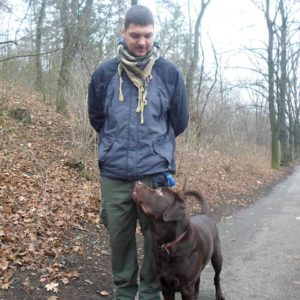To educate, train and to live with the dog effectively, we need the dog to pay attention to us gladly. Traning and educating is communication – passing of information from us to the dog. And it is not possible to pass information to someone if he is not paying attention to us.
The dog needs to be primarily able to pay us the attention – so he needs to be socialized and habituated correctly. Secondly, the dog needs to see the meaning in paying the attention to us – we need to be worth to be followed.

It is a mistake to try to gain dog´s attention using food treat – treats are a very good training tool, but it needs to be used correctly. Earning the attention by food treat in situations, in which the dog is ignoring us is not a correct usage. In this context, it will be difficult to phase out the food treat and we are risking, that the dog will learn to pay attention to us only if we have some treat in our hand – and great training tool will become a bribe.
It is appropriate, to consider the attention as a separate task and to practice some exercises which will increase the probability, that the dog will look at us, and pay attention to us when we ask him to. One of such an attention exercises is an exercise I called “Look”:
- Put a treat in a closed fist
- Let the dog try various strategies to get the treat – most probably he will sniff or lick the hand
- Then he will be trying other strategies and soon or later, he will try to look at you
- Immediately use verbal reward like “good dog” and open the fist and let the dog eat the treat
- Repeat
- We will see, that the time for the dog to decide to look at us is shorter – the dog will look at us with higher probability
- We can make the time the dog has to look at us to get the treat little longer: at first one second, then two seconds…
- Now the dog understands the game – he needs to look at us to get the treat
- At this point, we can start to use the verbal cue, which we want to connect with looking. For example “look”. We will say the cue before the dog looks at us, what we can predict now.
The dog is learning, that looking at us is an effective strategy. What we can practice now is to ask the dog to look at us before we give him a toy, before we release him from the leash, before we open the door for him…
Practice the exercise in the kitchen, living room, during the walk… Increase the difficulty of the environment gradually. If the dog is reacting correctly to the “look” cue does not mean automatically, that he will react correctly for example in a dog park among other dogs – but this is what we want to achieve – gradually.
Of course. we have to engage the empathy and common sense. We do not have to demand to look in every situation. We do not want to bully the dog with this. What we want is, that the strategy “I will look at my human” will become automatic and more natural for the dog than for example strategy “I will bark” or “I will jump” and so on.
